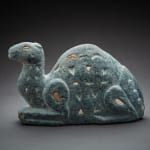Bactria-Margiana Inlaid Stone Camel, 2500 BCE - 1500 BCE
Stone
16.5 x 25.4 cm
6 1/2 x 10 in
6 1/2 x 10 in
AM.0126
Further images
This impressive inlaid stone camel was found in the now-extinct country of Bactria, spread across what are now Turkmenistan, Tajikistan, Uzbekistan and Northern Afghanistan. It was one of many economic...
This impressive inlaid stone camel was found in the now-extinct country of Bactria, spread across what are now Turkmenistan, Tajikistan, Uzbekistan and Northern Afghanistan. It was one of many economic and social entities in the vicinity, and was a powerful country due to the exceptional fertility and wealth of its agricultural lands. This in turn gave rise to a complex and multifaceted set of societies with specialist craftsmen who produced luxury materials such as this for the ruling and aristocratic elites. For this reason, the area was fought over from deep prehistory until the Mediaeval period, by the armies of Asia Minor, Greece (Macedonia), India and the Arab States, amongst others.
While Bactria has been a force throughout much of the past 6000 years, the civilisation referred to as the Oxus (or the BMAC) is perhaps the most notable. Flourishing between about 2100 and 1700 BC, it was contemporary with the European Bronze Age, and was characterised by monumental architecture, social complexity and extremely distinctive cultural artefacts that vanish from the record a few centuries after they first appear. Trade was a major issue, with artefacts turning up all over the Persian Gulf as well as on the Iranian Plateau and the Indus Valley. Pictographs on seals have been argued to indicate an independently-developed writing system; they appear to have worshipped deities symbolised by stone seated women with detachable heads made of ivory or bone. The crafts, as stated above, extended into zoomorphic and anthropomorphic statuary in gold, silver, stone and ceramic. While the function of these objects is unclear, it is possible that they occupied some cult purpose.
The sculpture is executed in a hard, heavy grey stone of uncertain composition. The camel is shown in a recumbent posture, with legs tucked in under the body. The limbs are in low relief, giving the animal a slightly cubist, expressionist look. Incised decoration is restricted to the tail and the top of the head that are both decorated with lines and elevated hatching. The mouth is also marked in incised lines while the ears are shown as slight relief protuberances. The whole body of the animal and its eyes are decorated with symmetrically-placed inset pieces of light-coloured stone in the shape of crescents, triangles and ovals with a single pointed end. Some of the insets are missing, commensurate with the age of the piece, leaving the carefully-prepared indentations bare. The length of the tail is marked by four triangular insets on each side, and the neck with eight on each side. There is a single midline triangle (white) on the apex of the head, and two more shallow scrapes on the rear aspect of the camel’s hump. This is an intriguing and well-carved piece of ancient Central Asian art.
While Bactria has been a force throughout much of the past 6000 years, the civilisation referred to as the Oxus (or the BMAC) is perhaps the most notable. Flourishing between about 2100 and 1700 BC, it was contemporary with the European Bronze Age, and was characterised by monumental architecture, social complexity and extremely distinctive cultural artefacts that vanish from the record a few centuries after they first appear. Trade was a major issue, with artefacts turning up all over the Persian Gulf as well as on the Iranian Plateau and the Indus Valley. Pictographs on seals have been argued to indicate an independently-developed writing system; they appear to have worshipped deities symbolised by stone seated women with detachable heads made of ivory or bone. The crafts, as stated above, extended into zoomorphic and anthropomorphic statuary in gold, silver, stone and ceramic. While the function of these objects is unclear, it is possible that they occupied some cult purpose.
The sculpture is executed in a hard, heavy grey stone of uncertain composition. The camel is shown in a recumbent posture, with legs tucked in under the body. The limbs are in low relief, giving the animal a slightly cubist, expressionist look. Incised decoration is restricted to the tail and the top of the head that are both decorated with lines and elevated hatching. The mouth is also marked in incised lines while the ears are shown as slight relief protuberances. The whole body of the animal and its eyes are decorated with symmetrically-placed inset pieces of light-coloured stone in the shape of crescents, triangles and ovals with a single pointed end. Some of the insets are missing, commensurate with the age of the piece, leaving the carefully-prepared indentations bare. The length of the tail is marked by four triangular insets on each side, and the neck with eight on each side. There is a single midline triangle (white) on the apex of the head, and two more shallow scrapes on the rear aspect of the camel’s hump. This is an intriguing and well-carved piece of ancient Central Asian art.





